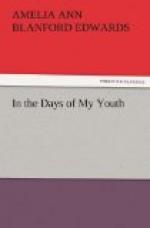At the other extremity of the town, down by Girdlestone Grange, an old moated residence where the squire’s family have resided these four centuries past, we are full fifty years behind our modern neighbors. Here stands our famous old “King’s-head Inn,” a well-known place of resort so early as the reign of Elizabeth. The great oak beside the porch is as old as the house itself; and on the windows of a little disused parlor overlooking the garden may still be seen the names of Sedley, Rochester and other wits of the Restoration. They scrawled those autographs after dinner, most likely, with their diamond rings, and went reeling afterwards, arm-in-arm, along the village street, singing and swearing, and eager for adventures—as gentlemen were wont to be in those famous old times when they drank the king’s health more freely than was good for their own.
Not far from the “King’s Head,” and almost hidden by the trees which divide it from the road, stands an ancient charitable institution called the College—quadrangular, mullion-windowed, many-gabled, and colonized by some twenty aged people of both sexes. At the back of the college, adjoining a space of waste ground and some ruined cloisters, lies the churchyard, in the midst of which, surrounded by solemn yews and mouldering tombs, stands the Priory Church. It is a rare old church, founded, according to the county history, in the reign of Edward the Confessor, and entered with a full description in Domesday Book. Its sculptured monuments and precious brasses, its Norman crypt, carved stalls and tattered banners drooping over faded scutcheons, tell all of generations long gone by, of noble families extinct, of gallant deeds forgotten, of knights and ladies remembered only by the names above their graves. Amongst these, some two or three modest tablets record the passing away of several generations of my own predecessors—obscure professional men for the most part, of whom some few became soldiers and died abroad.
In close proximity to the church stands the vicarage, once the Priory; a quaint old rambling building, surrounded by magnificent old trees. Here for long centuries, a tribe of rooks have held undisputed possession, filling the boughs with their nests and the air with their voices, and, like genuine lords of the soil, descending at their own grave will and pleasure upon the adjacent lands.
Picturesque and mediaeval as all these old buildings and old associations help to make us, we of Saxonholme pretend to something more. We claim to be, not only picturesque but historic. Nay, more than this—we are classical. We were founded by the Romans. A great Roman road, well known to antiquaries, passed transversely through the old churchyard. Roman coins and relics, and fragments of tesselated pavement, have been found in and about the town. Roman camps may be traced on most of the heights around. Above all, we are said to be indebted to the Romans for that inestimable breed of poultry in right of which we have for years carried off the leading prizes at every poultry-show in the county, and have even been enabled to make head against the exaggerated pretensions of modern Cochin-China interlopers.




